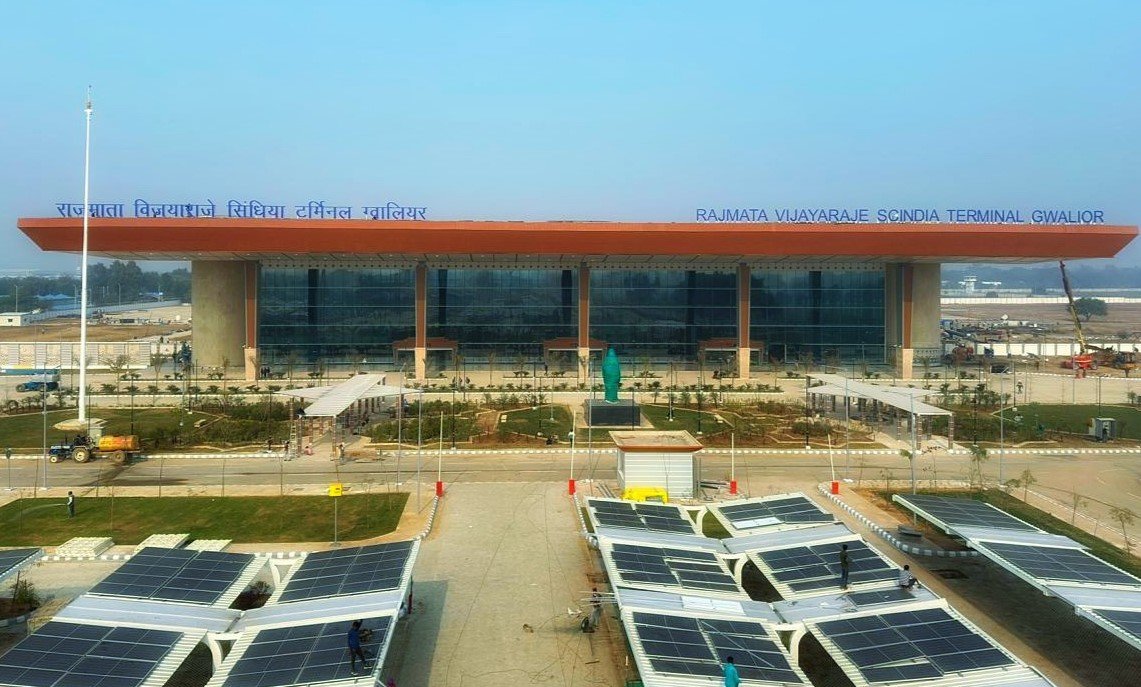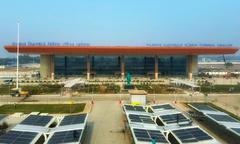
Complete Guide to Gwalior Airport Visiting Hours, Tickets, and Madhya Pradesh Travel
Date: 14/06/2025
Introduction to Gwalior Airport and Madhya Pradesh Travel
Gwalior Airport, officially known as Rajmata Vijaya Raje Scindia Air Terminal, stands as a prominent aviation hub in Madhya Pradesh, seamlessly blending its rich historical heritage with modern travel amenities. Established in the late 1930s, the airport originated as a strategic military base during World War II and has since evolved into a dual-use facility, supporting both Indian Air Force operations and commercial passenger services. This unique legacy positions Gwalior Airport as both a critical gateway to central India and a symbol of the region’s progress (IAFHistory.in, Wikipedia).
Travelers enjoy a range of facilities, including wheelchair accessibility, modern amenities, and efficient connectivity to major Indian cities through airlines such as Air India, IndiGo, and SpiceJet. With operational hours extending from early morning to late evening, and convenient online ticketing, the airport ensures a smooth experience for both leisure and business visitors (The Packers Movers, FlyAirports).
Gwalior Airport also provides easy access to the region’s cultural treasures. Landmarks such as the majestic Gwalior Fort, Jai Vilas Palace, Gujari Mahal Archaeological Museum, and Teli Ka Mandir are within close reach, offering travelers a gateway to India’s architectural and historical legacy (Tripcrafters).
Significant infrastructure expansions are underway, including a new terminal building designed to dramatically increase passenger capacity and traveler comfort, reflecting the state’s commitment to tourism and economic growth (Economic Times Travel, Financial Express).
This comprehensive guide covers Gwalior Airport’s history, visitor information, ticketing, accessibility, and recommendations for exploring local historical landmarks—ensuring a rewarding journey through Gwalior and Madhya Pradesh.
Airport History: Strategic Origins and Evolution
Early Foundations
Gwalior Airport’s history began in the late 1930s when Maharajpur village was selected for aviation development. With the Maharaja’s approval in 1937, a seaplane base at Madhosagar Lake and an aerodrome at Maharajpur were constructed, transforming the area into a strategic aviation hub (IAFHistory.in). By 1940, during WWII, the airstrip became operational as the No. 49 Staging Post for the Royal Air Force, underlining its early military importance.
Post-Independence Developments
After 1947, the Indian Air Force planned to expand its network, viewing Maharajpur as ideal for a heavy bomber fleet. However, the Maharaja’s continued use of key buildings delayed military development into the late 1950s. Eventually, bomber squadrons were stationed elsewhere, but the base continued to grow in strategic significance (IAFHistory.in).
Modern Airbase and Dual-Use Facility
In the 1960s, the No. 3 Air Force Selection Board and No. 2 Base Repair Depot were established. The airbase was upgraded in 1982 and, by 1985, housed India’s Mirage-2000 fleet and the elite Tactics and Air Combat Development Establishment (TACDE), India’s “Top Gun School” (IAFHistory.in). Today, the civil enclave operates alongside the military base—a model of efficient, secure, dual-use aviation infrastructure (The Packers Movers).
Visitor Information: Operating Hours, Ticketing, and Facilities
Operating Hours
The civil enclave at Gwalior Airport operates daily from early morning (around 5:00 AM) until late evening (around 11:00 PM), aligned with commercial flight schedules. Specific timings may vary; confirm with your airline or the airport’s official website.
Ticket Booking
Flights can be booked through major airline websites (Air India, IndiGo, SpiceJet), travel agencies, or popular online booking platforms. Air India is the primary carrier, offering regular domestic connections to Mumbai, Indore, Delhi, and Bhopal. For international destinations, connections via Delhi’s Indira Gandhi International Airport (about 335 km away) are recommended (The Packers Movers).
Passenger Services and Facilities
- Accessibility: Wheelchair access, dedicated assistance counters, and accessible restrooms.
- Amenities: Waiting lounges, refreshment stalls, baby care rooms, medical centers, and free Wi-Fi.
- Transportation: Taxis, auto-rickshaws, app-based cabs (Ola), and car rental services operate from the airport. Limited public bus connectivity is also available (FlyAirports, Tusk Travel).
- Security: Stringent security checks due to the military presence.
Modernization and Expansion
To accommodate rising demand, a new terminal building spanning 20,000 m² is underway, expected for completion by 2025. This expansion will multiply passenger capacity sevenfold, add parking and city-side development, and support 13 narrow-body or small aircraft simultaneously (Economic Times Travel, Wikipedia).
Sustainability initiatives include rainwater harvesting and a 2.5 GW solar power plant, highlighting the airport’s commitment to green infrastructure.
Economic and Regional Impact
Gwalior Airport serves as a critical gateway to central India, connecting Gwalior to major metros and facilitating regional tourism, business, and economic growth. Weekly flights statewide have doubled, boosting local industries and employment (Financial Express, WTTC).
Cultural and Heritage Significance
Named after Rajmata Vijayaraje Scindia, the airport honors Gwalior’s royal and political heritage. Its proximity to iconic landmarks such as Gwalior Fort, Jai Vilas Palace, and Gujari Mahal Museum invites travelers to explore the city’s vibrant history and cultural riches (Tripcrafters).
Nearby Historical Sites: Gwalior Fort and More
Gwalior Fort: The Crown Jewel
Perched atop a steep hill, Gwalior Fort is renowned for its palaces, temples, and panoramic city views. Dating back over a millennium, it has witnessed the reign of Tomars, Mughals, Marathas, and the British.
- Visiting Hours: Daily, 7:00 AM – 6:00 PM
- Tickets: ₹30 (Indian nationals), ₹500 (foreign nationals), free for children under 15
- Guided Tours: Available on request; audio guides and brochures provided
Facilities and Accessibility
- Restrooms, water points, souvenir shops, and shaded seating areas within the complex
- Steep terrain; limited accessibility for differently-abled visitors—assistance available by request
How to Reach
- By Air: Gwalior Airport (8–10 km from city); domestic flights connect major cities
- By Rail: Gwalior Junction (4 km from fort); taxis and auto-rickshaws available
- By Road: Well-connected highways; accessible by car, bus, or local transport
Nearby Attractions
- Jai Vilas Palace Museum: Showcases royal artifacts
- Sas-Bahu Temples: Renowned for intricate carvings
- Gujari Mahal Archaeological Museum: Features regional relics
- Teli Ka Mandir: Unique ancient temple
Best Time to Visit
October–March offers the most pleasant weather. Mornings and late afternoons are ideal for photography.
Frequently Asked Questions (FAQs)
What are Gwalior Airport’s visiting hours?
5:00 AM to 11:00 PM daily; check flight schedules for updates.
How can I book flight tickets?
Via airline websites (IndiGo, Air India, SpiceJet), travel agencies, or online platforms.
What facilities are available at the airport?
Free Wi-Fi, lounges, wheelchair assistance, baby care rooms, medical centers, parking, and taxi services.
Is the airport accessible for differently-abled passengers?
Yes, with accessible restrooms and assistance counters.
What are notable attractions near the airport?
Gwalior Fort, Jai Vilas Palace, Gujari Mahal Museum, Teli Ka Mandir, and more.
Conclusion and Travel Tips
Gwalior Airport is more than a transit facility; it is a vibrant hub that bridges history, culture, and modern convenience. With expanding infrastructure, sustainable initiatives, and proximity to iconic heritage sites, it offers travelers a unique entry point to Madhya Pradesh’s rich legacy.
Travel Tips:
- Arrive early for security checks.
- Book tickets in advance, especially during peak seasons.
- Use local guides for enriched historical insights.
- Wear comfortable footwear for exploring heritage sites.
Stay up-to-date on schedules, facilities, and local attractions by downloading the Audiala app. Explore related travel resources and follow us on social media for the latest tips and announcements. Begin your journey through central India at Gwalior Airport—where history and modernity meet.
Official Gwalior Tourism Website
Airports Authority of India - Gwalior Airport
Sources
- IAFHistory.in
- Wikipedia
- The Packers Movers
- FlyAirports
- Tusk Travel
- Financial Express
- Tripcrafters
- Economic Times Travel
- WTTC
